Intel Reveals More About Sandy Bridge Core CPUs
Intel has shown us what Sandy Bridge looks like in chip form.
Sandy Bridge is Intel's code name for the next-generation of Core microarchitecture, and also the biggest leap in CPU technology for the company since its introduction of Nehalem.
This part takes Westmere's integrated graphics strategy and pushes a faster GPU into the same die as the CPU, all built on a 32nm process. With the two parts inside the same die, both share cache and the graphics part picks up a few tricks from the CPU. The IGP on Sandy Bridge will utilize the same power management as CPU as well as be capable of Turbo Boost. The graphics part itself will support DirectX 10.1 features, but anyone who wants DX11 will probably have a discrete part already on his build list.
Check out some more detail from the slides from the Sandy Bridge presentation at IDF.


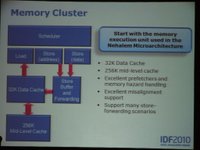



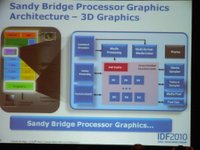
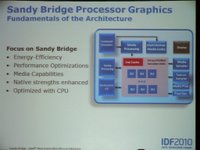





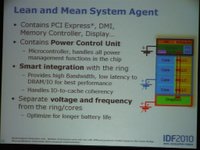






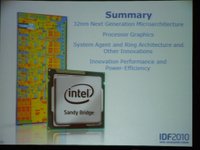
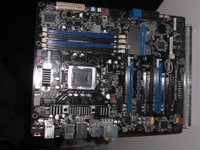


Intel also sent out a press release related to the event.
Intel Details 2011 Processor Features, Offers Stunning Visuals Built-inSAN FRANCISCO, Sept. 13, 2010 - Intel Corporation revealed today several significant design features for the company's 2011 2nd Generation Intel® Core™ processor family at the Intel Developer Forum. The new and enhanced features will further extend Intel's chip performance and battery life leadership, and add a number of visually related features built right into the chips.Codenamed "Sandy Bridge," the chips will be based on Intel's first new "visibly smart" microarchitecture produced on the company's cutting-edge manufacturing factories, or "fabs," at 32-nanometer (nm is a billionth of a meter) process technology with second- generation high-k metal gate transistors."The way people and businesses are using computers is evolving at an explosive rate, fueling demand for an even more powerful and visually appealing experience," said Dadi Perlmutter, executive vice president and general manager of the Intel Architecture Group. "Our upcoming 2nd Generation Intel Core processor family represents the biggest advance in computing performance and capabilities over any previous generation. In addition to offering these features inside Intel-based laptops, we plan to scale these advances across our server data center and embedded computing product portfolio."The processor family will include a new "ring" architecture that allows the built-in processor graphics engine to share resources such as cache, or a memory reservoir, with the processor's core to increase a device's computing and graphics performance while maintaining energy efficiency.The 2nd Generation Intel Core processor also includes an enhanced version of Intel® Turbo Boost Technology. This feature automatically shifts or reallocates processor cores and processor graphics resources to accelerate performance, tailoring a workload to give users an immediate performance boost when needed.Laptops and PCs powered by the 2nd Generation Intel Core processor family are expected to be available early next year.New Visual Experience - Visibly SmartIntel's new processor graphics delivers enhanced visual features focused on the areas where most users are computing today: HD video, 3-D, mainstream gaming, multi-tasking and online socializing and multimedia.To obtain and view video faster, Perlmutter demonstrated hardware accelerated video editing using the architecture's dedicated silicon for media processing, which allows users to quickly convert video to other formats.The 2011 chips also come with Intel Advanced Vector Extensions (AVX). AVX delivers improved performance, rich functionality and the ability to better manage, rearrange and sort data. A new 256-bit instruction set accelerates floating point intensive applications such as digital photo editing and content creation.Intel also demonstrated a dual processor, next-generation Intel® Xeon® processor server running Vidyo* video conferencing software that utilizes the 32 threads available on the system, and takes advantage of the AES New Instructions set (AESNI). Next-generation Xeon™ processors for 2 socket servers and workstations run 8 cores and 16 threads per processor and are on schedule for production in the second half of 2011.
Special thanks to Uwe Scheffel from Tom's Hardware Germany.
Get Tom's Hardware's best news and in-depth reviews, straight to your inbox.
-
victorintelr Very interesting concept to put together the CPU and GPU, though if they ever hope to catch with AMD/Nvidia graphic performance...They still have a loooooong way to go. AMD have ATI at its disposition and certainly got a good advantage already. Intels still relies on its CPU for the most taxing tasks.Reply -
LORD_ORION Wake me up when integrated GPUs on CPUs do 60FPS in Crysis with max details at 1080 res.Reply -
banthracis So slide 17 says they're keeping the integrated PCI-e from P55. Does this mean that we'll once again have a 16 total PCIe Lane limit or was this issue resolved?Reply
Also, did Intel decouple the PCIe controller from BCLK? One of the biggest issues with Lynnfield was the stupid (and pointless) coupling of the 2 which limited stock v overclocking greatly. -
enzo matrix zipzoomflyhighSeems like they just tweaked Nehalem and added gpu. It's sad the s1155 wont be backwards compatible with s1156. At least with AMD's new AM3+ socket you will still be able to drop in your old AM3 cpu.No you won't.Reply
http://www.xbitlabs.com/news/cpu/display/20100826225852_Desktop_Bulldozer_Processors_Will_Require_New_Platforms_AMD.html
"Apparently, it was possible for AMD to make Bulldozer microprocessors compatible with existing AM3 infrastructure, but in order to do that, the company would have to sacrifice certain important features of the new core."
So they won't be throwing us old AM3 or AM2+ users a bone. -
truerock The Intel X58 Tylersburg based platform will likely be replaced by X68 Waimea Bay which includes a Sandy Bridge-E CPU and a Patsburg PCH.Reply
Waimea Bay / Patsburg = high-end
Cougar Point = low-end
http://vr-zone.com/articles/a-look-into-intel-s-next-gen-enthusiast-platform--sandy-bridge-e--waimea-bay/8877-1.html
http://www.semiaccurate.com/2010/08/12/intels-patsburg-chipset-comes-few-unexpected-surprises/
Waimea Bay Highend Desktop (HEDT) Overview
Earlier on, we had unveiled chipset specifications for Intel Mainstream (MS) desktop in 2011, but at that point in time, little was known of what would replace the Tylersburg Enthusiast Platform consisting Intel X58 Express chipset + i7-980X "Gulftown" CPU. With LGA1155 Sandy Bridge-MS samples already shipping, it even looked like we'd have the Tylersburg Enthusiast Platform sticking with us for a very long time.
Before you join the uninformed; concluding that there wouldn't be an enthusiast platform on Sandy Bridge microarchitechture in 2011, we'd like to show you some exclusive knowledge about Intel's next generation HEDT.
Intel will stick to using differentiated desktop platforms for the purpose of market segmentation in 2011. The LGA1155 Sandy Bridge-MS we've heard about over the past months will join the Cougar Point family of chipsets to corner the Mainstream and Essential market segments. For the highend segment, Waimea Bay will take the lead by joining Sandy Bridge-E processors to the Patsburg Platform Controller Hub (PCH). Because Sandy Bridge on LGA1155 will only be available in 2 core and 4 core versions, those looking forward to having 6 cores or more will have to put their money where it counts: on the Waimea Bay platform.
Intel also has intentions to market their next generation "Taylorsville" 6Gb/s Solid State Drives (SSDs) as a complement to the Waimea Bay HEDT platform.



